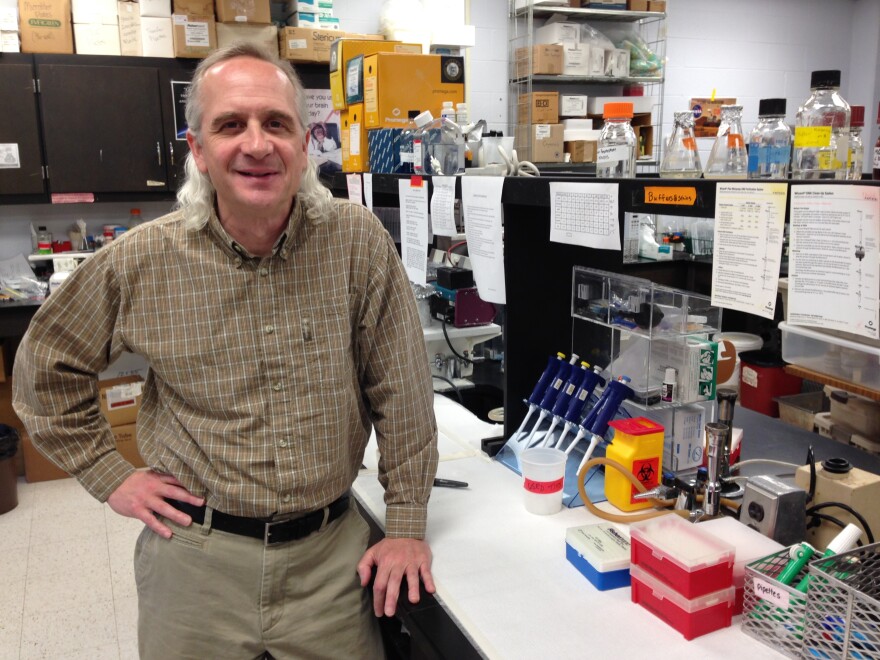
This story originally aired during Morning Edition on 05/04/2014.
Residents of a West Wichita neighborhood learned in March that their private water wells had been contaminated with a chemical likely to cause major health defects. They’ve also learned that the contamination could be decades old.
Ron Barnhart owns a well groomed, one story home in west Wichita.
“We came here in ’64,” he says. “This was my parent’s house. I would always ask my dad through those years, you know, ‘Dad, what’s filtering that water coming from the ground?’ He had a filter down, but it wasn’t sufficient to put up with this.”

What Barnhart is referring to is a likely carcinogenic chemical called tetrachloroethylene or PCE. A plume of it was extending nearly two miles, from West Central to West Kellogg, currently sits under his home. Barnhart and his neighbors were notified in March that their water wells had been contaminated. His first thoughts were of the safety of his children.
“I’m almost 60, so it’s not about me; it’s about that five-year-old and that six-year-old,” he says, pointing to his two children. “I don’t want them exposed to it. I’m in perfect health now. My folks lived in this home for 40 to 50 years; they both lived into their eighties.”
Barnhart and his neighbors learned about the dangers posed by PCE when the Kansas Department of Health and Environment held a meeting for those in the affected area.
Bob Jurgens, chief of the Kansas Department of Health and Environment's Dry Cleaning Remediation Program, led the neighborhood meeting. He told the hundreds in attendance that PCE has been used by dry cleaners starting in the 1950’s. It’s effective in removing organic material, such as dirt or grease, from clothing. It can also cause liver damage and cancer in humans and animals.
Finding PCE in this area was in some ways an accident, according to Chris Whitley of the Environmental Protection Agency. He explains that in 2009, the EPA helped fund an investigation of radium at 7920 W Kellogg, a site where radium dials were once manufactured.
“That was for a facility called Standard Products, and in the course of that investigation, PCE was detected,” he explains. “But it was detected at levels below what EPA or KDHE would have considered the action level.”
This 2009 investigation marks the first test for PCE in the area near Standard Products. It was added to a “sites to be investigated” list, which is maintained by KDHE. But it would be over four years before they returned to investigate the source of the contamination.
“Previously the chronological list had really taken care of those sites of concern,” says Sara Belfry, spokesperson for KDHE. “With an increase in the number of sites we were receiving, we chose to go to with more of a risk-based process of selecting those sites and making sure they get to the EPA.”

Changing the priority from when a contamination was found to how severe it was shuffled the deck; the West Kellogg contamination was now added to the list of sites to receive federal funding. Belfry says that these investigations can cost around $6,000, but a tally for funds invested so far at this site was not available. KDHE started their investigation in November of last year.
“We were doing different tests and investigations of groundwater and soil. In late February, we started testing private wells. Late March we figured out that the Four Seasons Dry Cleaner site was the origin of the PCE chemical.”
The former Four Seasons Dry Cleaners was located at 8947 West Central Street. It’s now a dollar store with a cake shop and Mexican restaurant as its neighbors. It went out of business when a fire damaged it in 2006. The site has seen a dry cleaner since the 1950’s, when Cowboy Cleaners was open. It is possible that the PCE contamination goes back that far.
“PCE is a human or animal carcinogen; it’s in a class that they call suspected, or likely carcinogens,” says Mark Schneegurt, an environmental biology professor at Wichita State University.

He adds that there isn’t a lot of hard data on the effects of high levels of PCE on humans.
“We typically aren’t getting a lot of humans that are getting this kind of exposure," Schneegurt says. "We don’t have a lot of experience with humans, so we use animal models. Animal systems are different than human systems, so although we learn something from the animal systems, it’s not a hard and fast rule.”
What we do know about PCE is that the effects are often seen over time, according to Schneegurt. This can come from drinking tainted water, or from a dry cleaning employee inhaling it for many years.
“What you will get are these chronic effects, and these are less defined. But the type of things that you’d expect from PCE is what you’d expect from a lot of organic chemicals: liver damage, kidney damage, those types of things…over prolonged periods of time, with repeated exposures at a reasonable level,” Schneegurt says.
He says, "If you were drinking it, and it was at high enough level, and you continuously drank it over long periods of time, then you’re probably at risk of getting some of these health effects.”
These effects were covered in the meeting KDHE organized. But prior to that, many residents only received a letter stating that their water wells were contaminated. Lela Hill is one of those residents.
“It didn’t give enough information for us to realize how important it was for us to get our water checked…so we didn’t,” she says. “Then our neighbor had his checked, and let us know what was going on. So that’s when we called the number on his letter, and we got someone out here to check our water.”
Hill’s water well ended up measuring 134 micrograms of PCE per liter, much higher than the EPA’s maximum contaminant level of 5 micrograms per liter. Other water wells in the area are reading as high as 760 micrograms of PCE per liter, and there are still more to be tested.
“I guess we’ve been drinking this water for a long time, you know, health issues down the road," Hill says. "What’s going to happen since we’ve been exposed for a long time?”
In order to address the contamination, KDHE quickly dispatched bottled water to those affected. They also installed filters that are specifically designed to remove PCE from drinking water. They will pay for the city of Wichita to hook up over a dozen homes to the city’s water system. Sara Belfry of KDHE says that all of this work will not come cheap.
“It will be probably over a million dollars at the end: adding up all of the water mains, the bottled water, making sure everyone has filters, those kinds of things.”

Residents have been told that all of these expenses will be coming from Kansas’ Dry Cleaner Remediation Trust, which is created through fees that dry cleaners pay when purchasing PCE, as well as a tax customers pay when picking up their clothes.
The Kansas Department of Health and Environment is looking to investigate if anyone can be found responsible for the initial contamination.
A former owner of Four Seasons Dry Cleaners did not want to be included in this story.
Click here for a full-size map of the PCE plume in West Wichita, including contaminant levels.
Jordan Kirtley contributed to this report.
Follow Sean Sandefur on Twitter, @SeanSandefur





